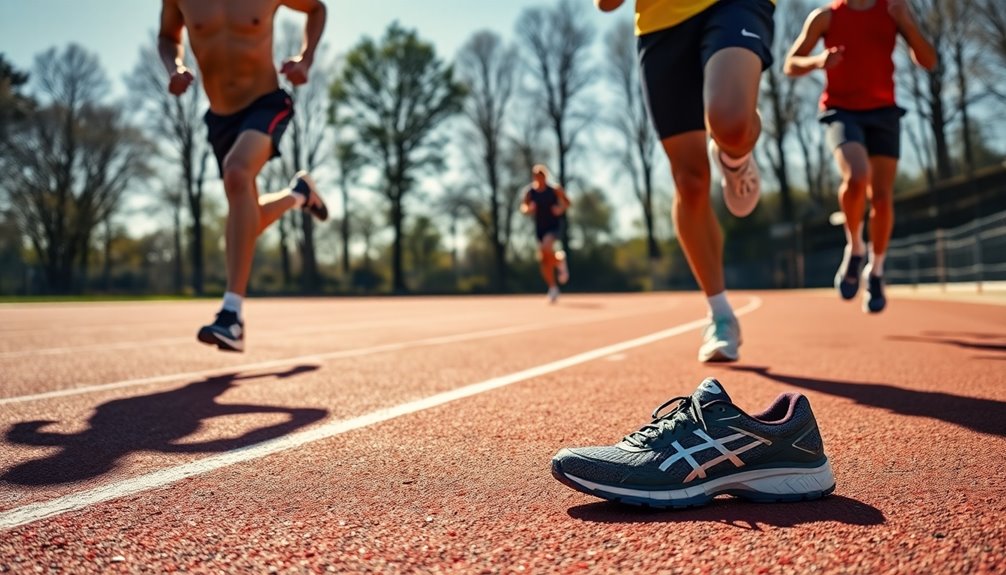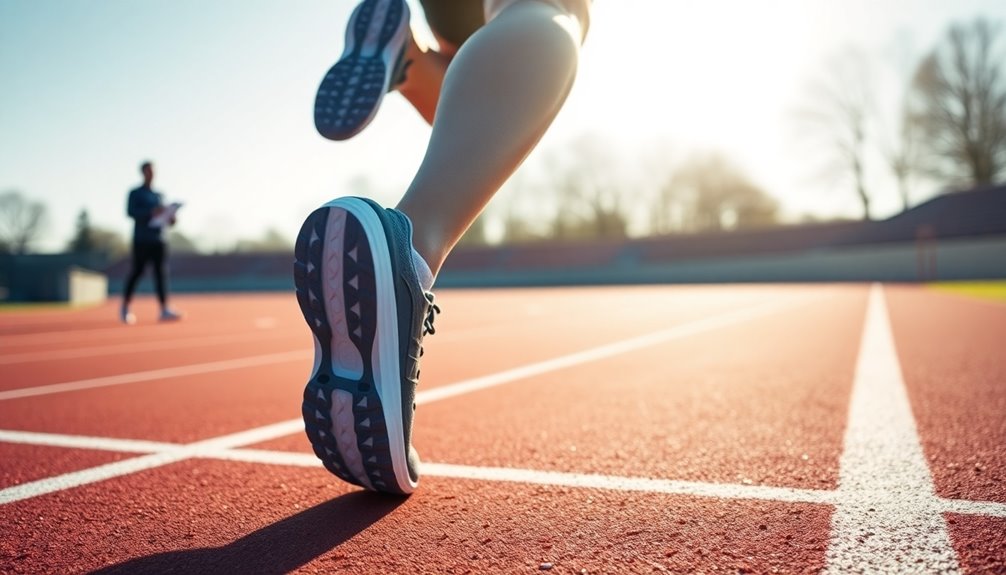To optimize your running technique for efficiency, focus on maintaining proper posture, improving your footstrike patterns, and enhancing your core strength. Keep your spine erect, land under your hips, and engage your glutes to avoid injuries. Pay attention to your cadence—aim for around 180 steps per minute—and practice diaphragmatic breathing for better oxygen intake. Incorporating cross-training can also boost your skills and resilience. There's much more to explore to enhance your running performance effectively.
Key Takeaways
- Maintain an erect spinal alignment and a slight forward lean from the ankles to enhance oxygen intake and reduce lower back strain.
- Focus on landing under your hips with a midfoot or forefoot strike to improve efficiency and reduce over-striding.
- Aim for a cadence of around 180 steps per minute to lower injury risk and improve overall running performance.
- Incorporate strength training for your core and glutes to maintain form, enhance stability, and prevent injuries during runs.
- Use diaphragmatic breathing techniques to optimize oxygen intake and maintain a relaxed posture, supporting efficient running rhythm.
The Importance of Running Technique

When you pay attention to your running technique, you greatly reduce your risk of injury and boost your performance. Proper running technique is vital for efficient running.
Focus on maintaining good posture by avoiding over-striding and ensuring your foot lands directly under your hips. Research shows that increasing your cadence by about 5% can help you prevent injury, with an ideal target of around 180 steps per minute.
Strengthening your core and glutes is also essential, as weaknesses here can lead to form issues and increase injury risk. Additionally, understanding emotional regulation can enhance your mental focus during runs, contributing to better overall performance.
Understanding Common Running Styles

When it comes to running, you'll notice different styles like heel striking, midfoot striking, and forefoot striking.
Each of these patterns affects how you run and can influence your comfort and performance. Understanding emotional dysregulation can also improve your mental focus during runs, as it plays a critical role in maintaining a steady mindset.
Types of Running Styles
Three primary running styles dominate the landscape of runners: heel striking, forefoot striking, and midfoot striking.
The heel strike, which is the most common among elite half-marathoners, involves landing on your heel first. This style can be comfortable but may not always be the most efficient.
On the other hand, forefoot strikers land on the balls of their feet, which allows for better energy absorption and propulsion.
The midfoot strike, a blend of both techniques, strikes a balance between comfort and efficiency.
Ultimately, the best type of running style for you depends on your individual biomechanics and comfort level.
Experimenting with these types of running styles can enhance your efficiency and help reduce injury risk over time. Additionally, adopting energy-efficient systems like heat pumps can further optimize your overall performance by improving your environment.
Impact of Footstrike Patterns
How does your footstrike pattern impact your running performance? Understanding your footstrike is essential for optimizing running mechanics and reducing impact forces. Most runners, approximately 75% of elite half-marathoners, are heel striking, which doesn't greatly increase injury risks. However, landing directly under your hips can minimize over-striding and enhance efficiency. Shifting to a midfoot or forefoot strike can improve foot loading and comfort, leading to a more natural form. Remember, the right footwear plays an important role in supporting your style and influencing your performance. Additionally, incorporating diversified investments in your training can help manage the physical demands of running.
| Footstrike Type | Pros | Cons |
|---|---|---|
| Heel Strike | Common, less injury risk | Potential for over-striding |
| Midfoot Strike | Balanced, versatile | Requires adjustment |
| Forefoot Strike | Efficient, natural movement | May lead to calf strain |
Personalizing Your Technique
Many runners discover that personalizing their technique can considerably enhance comfort and performance.
You'll find that running styles typically fall into three categories: heel strike, midfoot strike, and forefoot strike. While heel striking is common among elite half-marathoners, experimenting with different techniques is essential for good running.
Each individual's physical structure influences what feels right, so seek the correct running form that suits you. For instance, shifting to a forefoot strike can improve shock absorption.
Additionally, if you're overstriding, try increasing your cadence by about 5%. This simple adjustment can help keep your foot strike directly under your hips, reducing impact forces and minimizing injury risk while boosting overall efficiency in your runs. Furthermore, continuous learning about different running techniques can lead to improved performance and injury prevention.
Key Components of Proper Posture

To run efficiently, you need to focus on key components of proper posture. Erect spinal alignment, hip extension, and core stability are critical for maintaining balance and reducing injury risks. Additionally, understanding trademark safeguards can help athletes protect their brand and image while promoting their running techniques.
Erect Spinal Alignment
Erect spinal alignment is essential for maximizing your running performance. When you maintain this posture, you promote efficient breathing and ideal oxygen intake, which are vital for endurance.
Lean slightly forward from your ankles instead of your waist to engage your core and enhance stability while reducing lower back strain. Keeping your head up and looking ahead aligns your spine, minimizing injury risks and improving your running mechanics.
Relax your shoulders, positioning them down and back to prevent tension that can hinder arm motion, important for balance and rhythm. Additionally, ensuring proper airflow around your body can help enhance your overall performance during runs.
Hip Extension Importance
While running, proper hip extension plays a pivotal role in maintaining an efficient posture. Engaging your glutes during hip extension stabilizes your pelvis, enhancing your running mechanics and helping prevent injuries.
A tall posture with an extended hip position allows for a forward lean from your ankles, which improves weight distribution and balance.
To optimize your hip extension and boost running performance, consider these key points:
- Focus on engaging your glutes to stabilize your pelvis.
- Maintain a tall posture for better alignment.
- Incorporate hip-flexor mobility exercises into your routine.
- Regularly monitor and adjust your hip extension while running.
Additionally, understanding how to protect your energy can help you stay focused and reduce fatigue during your runs.
Core Stability Focus
A strong core is the foundation of efficient running posture. To achieve this, you need to focus on core stability by maintaining a tall posture with a slight forward lean from your ankles. This alignment helps in engaging the core, stabilizing your pelvis and spine, which prevents over-striding and enhances your running mechanics.
Don't forget to relax your shoulders, keeping them down and back to reduce tension and improve your arm swing, which contributes to better balance and rhythm. Strong glutes are equally critical; they work in tandem with your core muscles for ideal stability.
Incorporating hip-flexor mobility exercises will also help maintain posture and prevent tightness, ensuring you run efficiently and reduce injury risk. Additionally, practicing deep breathing techniques can further enhance your overall performance by reducing tension and improving focus.
Strengthening Your Core and Glutes

Strengthening your core and glutes is essential for any runner looking to enhance performance and reduce the risk of injury.
Weak muscles in these areas can lead to instability and poor alignment, impacting your running economy. Incorporate targeted exercises to build strength and maintain proper form, especially during longer runs.
- Perform Single Leg Squats to activate your glutes and improve pelvic posture.
- Include hip-flexor mobility exercises to enhance hip extension and running posture.
- Regularly engage in core workouts to promote better control and reduce energy expenditure.
- Focus on strength training to avoid bad habits as fatigue sets in.
Additionally, incorporating stress management techniques can further support your running routine by enhancing your mental focus and resilience during training.
Breathing Techniques for Better Performance

How can mastering your breathing techniques transform your running performance? Proper breathing rhythm is essential; aim for a 2:2 ratio—inhale for two steps, exhale for two steps—at moderate exercise intensity to optimize oxygen intake.
As your pace increases, shift to a 3:2 or even 4:2 pattern to meet the higher oxygen demand without sacrificing performance. Incorporating diaphragmatic breathing will further enhance lung capacity, promoting greater respiratory efficiency.
Don't overlook controlled techniques like box breathing to help you stay calm and focused on race day. Remember to keep your shoulders relaxed while running; this allows for smoother arm movement, which directly supports your breathing patterns and overall running rhythm.
Master these techniques, and you'll see significant improvements in your performance.
The Role of Cadence in Running Efficiency

While you might focus on distance or speed, the role of cadence in running efficiency is crucial. An ideal cadence is around 180 steps per minute, which can help reduce the risk of running injuries by encouraging shorter, quicker steps. A slower cadence often leads to overstriding, increasing stress on your knees.
Consider these tips to improve your cadence:
- Use a metronome app to track your steps.
- Create a playlist with songs at 150 beats per minute or higher.
- Gradually increase your cadence by no more than 10% at a time.
- Focus on softer landings to reduce vertical oscillation.
Cross-Training for Enhanced Running Skills

Incorporating cross-training into your routine can greatly enhance your running skills and overall performance. Engaging in strength exercises, particularly for your core, quadriceps, hamstrings, and calves, can improve your speed, agility, and endurance.
Activities like cycling or swimming boost cardiovascular fitness while lowering the risk of overuse injuries tied to high-mileage running. Focus on glute activation and core stability to improve your running mechanics and efficiency.
Research shows that a well-rounded cross-training program also helps maintain your fitness during recovery periods, allowing you to return stronger. Additionally, regular sessions can enhance your neuromuscular coordination, essential for optimizing your form.
Injury Prevention and Management Strategies

To prevent injuries and manage existing issues effectively, it's crucial to adopt a proactive approach in your running routine.
Focus on the following strategies for injury prevention:
- Gradually increase your running mileage by no more than 10% per week.
- Implement a strength training routine to enhance glute activation and core stability.
- Monitor your foot lands to guarantee proper footstrike patterns under your hips, reducing over-striding.
- Use a numeric rating scale for pain during training, avoiding runs when pain exceeds 3/10.
Learning From Elite Runners

Injury prevention is just the beginning of optimizing your running performance. To run like elite athletes, focus on their higher cadence—around 180 steps per minute. This reduces impact forces and boosts efficiency.
Notice their arm swing; it's compact and relaxed, avoiding crossing over the midline, which enhances balance and rhythm.
Take cues from distance runners like Eliud Kipchoge, who lean slightly forward from the ankles, promoting energy efficiency and core engagement.
Pay attention to their footstrike; they land with their foot under their hips, minimizing over-striding and braking forces.
Finally, maintain an efficient posture by relaxing your shoulders and keeping your head up, aligning your spine and reducing unnecessary strain.
Emulating these techniques can greatly enhance your running performance.
Frequently Asked Questions
How Can I Improve My Running Efficiency?
To improve your running efficiency, focus on your cadence and aim for around 180 steps per minute.
Keep a tall posture with a slight forward lean to engage your core, and maintain a proper arm swing at a 90-degree angle.
Make sure your foot lands directly beneath your hips to avoid heel striking.
Also, incorporate glute-strengthening and core workouts into your routine to boost performance and prevent injuries.
What Is the 80% Rule in Running?
When it comes to running, you've got to know the lay of the land.
The 80% rule suggests you should run 80% of your weekly mileage at an easy pace. This approach helps build your aerobic capacity and lowers injury risks.
The remaining 20% can be dedicated to harder efforts like tempo runs. Sticking to this guideline keeps you balanced, allowing your body to recover and perform better in the long run.
How to Develop a Good Running Technique?
To develop a good running technique, focus on your posture first. Keep your body tall with a slight forward lean, engaging your core.
Aim for a cadence of around 180 steps per minute to improve foot strike.
Don't forget to warm up with hip-flexor mobility exercises, and practice swinging your arms correctly.
Gradually increase your mileage by no more than 10% weekly, always listening to your body and adjusting as needed.
How to Optimize Your Run?
Did you know that maintaining a cadence of around 180 steps per minute can considerably reduce your risk of injury?
To optimize your run, focus on keeping a tall posture with a slight forward lean. Use a metronome to gradually increase your cadence and guarantee your feet land directly under your hips.
Incorporating strength training, like single-leg squats, can also enhance your stability and overall performance, making your running experience more efficient and enjoyable.
Conclusion
As you lace up your shoes and hit the pavement, remember that optimizing your running technique transforms each step into a dance of power and grace. Picture yourself gliding effortlessly, the rhythm of your breath syncing with the beat of your heart. By focusing on posture, cadence, and strength, you'll not only run more efficiently but also savor the freedom of movement. Embrace these strategies, and watch as your running journey evolves into a beautiful, fluid experience.









